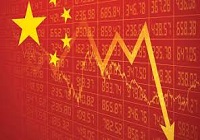Why did the Chinese Stock Market Crash so heavily and why did it rise so fast in the first place
The recent stock market crash in China has reduced the value of Shanghai composite by 1/3rd of the value within a span of three weeks. Can this be considered as the bursting of a tech bubble? Also, what caused this bubble? Can this be compared with the tech bubble burst in 2000? The essence of this article is to elucidate the answers to these questions.
Was there a Stock Market bubble in China? Let us first examine whether the situations prevailing in the Chinese market exhibit the characteristics of a tech bubble. A tech bubble is characterized by very high levels of speculation in the stocks of a particular industry, where prices of these stocks rise beyond a threshold limit without any fundamental backing. When the bubble reaches its pinnacle, a sea of tech companies try to raise capital by way of IPOs in an attempt to ride on the speculative market interest. In this case, the Shanghai composite index rose in value by approximately 50 in the preceding year. On an average, stocks traded at an implausible 220 times their reported profits, making the dot com bubble look meek in comparison. During
the year 2000, technology companies showed a mean price earnings ratio of 156. In the past year, China witnessed a total of 147 tech IPOs; companies fetched as much as 1,871 times their offer price. With these facts, it can be concluded that there was indeed a technology bubble in China.
Comparison between Dow Jones and Shanghai composite: The Shanghai Composite is not completely representative of the Chinese economy, unlike Dow Jones, that aims to provide a fair representation of the US Economy. The portrayal of manufacturing companies in the Shanghai composite is minimal. Manufacturing firms in the country, are state owned and are not listed in stock market, as China is a communist economy. Hence the Shanghai composite’s value does not give a true depiction of the economy. Another key difference is that companies from all over the world can be listed in Dow Jones whereas even the stocks of companies from Hong Kong are not included in the Shanghai composite. The other difference was that the composition of the technology sector in Chinese equity market was less than the composition of U.S technology sector in Dow Jones during 2000s.Adding to these, is the fact that retail investors are the key contributors to the Shanghai markets whereas Institutional investors are the key contributors in other dominant markets.
Efforts by the Chinese government to boost the economy and the consequences: The slowdown of the Chinese economy is evident, seeing the fact that an economy which has posted double digit growths for years together is now growing at 7.5%. The Chinese Government sought to diversify so as to decrease the over dependence of the economy on manufacturing. The Chinese government being the biggest net importer of oil, made huge savings in the past year due to the oil glut. Chinese savings had increased but the domestic demand and other economic indicators had slowed down implying that the economy was entering a deflationary phase. In order to trigger growth in the real economy, the government owned banks reduced the interest rates to create a boom in realty sector. As a result, the common man in China, taking advantage of the lower interest rates, borrowed heavily and subsequently invested in the markets, predominantly in technology stocks. ‘A-Shares’ were initially available for trade only by citizens of China and were listed in stock exchanges in the main land of China. ‘H -shares’ were shares of Chinese companies listed in Hong Kong Exchange, which were denominated in Hong Kong Dollars and could be traded by anyone but had to abide by conditions put forth by Chinese regulators. Certain companies (86) were listed as both ‘A Shares’ and ‘H Shares’. There always existed a price differential between the two; however, arbitrage was not possible due to the restrictions. The rally in A-shares started in the third quarter of 2014 not only due to local investors’ expectations for policy easing but also a shift in investment appetite away from the slowing Chinese property market into equities. This had spill over effects in Hong Kong markets. In November 2014,the Shanghai-Hong Kong Stock Connect was launched which proved to be a great boost to market sentiment as an inflow of foreign funds into A-Shares were expected. However, it is noteworthy that this linkage only promised a daily quota based trade and not a free link. Theoretically, an arbitrage was expected until the price differential became zero hence creating expectation for fair valuations of all the stocks. But this did not happen due to structural limitations. On the contrary, the premium of A Shares over H shares went up to as much as 130. In 2006-07, when a similar bubble was building in the main land stock markets, economic tightening was enforced, but in the recent case, due to the fear of recession, further monetary easing ensued leading to added inflation of the bubble.
Profile of the investors: In the past five years nearly 80% of the market turnover could be attributed to retail investors. This rocketed to 90% this year after 4-million new accounts were opened in March, bringing the total to 182-million.A recent survey showed that a shocking 67% of the investors were not even high school graduates. Unlike the Wall Street, most of the investors who inflated the Chinese bubble were novice investors- house wives, farmers and workmen who actually borrowed to invest in markets. Clearly they were speculators who had minimal understanding and only just ensured that it was a technology stock before investing. Marginal Financing: The stock market bubble was mainly fueled by easy availability of credit. In the past year, USD 339 million worth marginal financing was done (Marginal financing as a percentage of market capitalization in the main land China Stock Exchanges and NYSE is approximately same). However, the worrisome factor is that the amount of marginal financing taken had almost doubled in a year. However, it is important to note that there is a minimum threshold on the amount that can be borrowed from these brokerages and this also offered some scope for regulation. The most precarious trend was set when peer to peer online lending portals started blooming-these portals did not have a minimum threshold limit on borrowing and hence invited retail investors from the economically weaker strata to speculate. However, the annualized interest rates these online lending portals were charging were a whopping 22%. This offered extremely high leverage but what the retail investors failed to see was that it was a double edged sword and could result in extremely high losses if the returns on the stocks they invested fell. Magnitude of devastation caused by the bubble burst: It is estimated that when the markets fell, the investors lost money equivalent to 1.2% of China’s GDP. This is greater than the ‘combined’ value of losses that investors incurred during the 2000 dot com bubble burst and the 2008 financial crisis.
Click here for government certification in Accounting, Banking & Finance





13 Comments. Leave new
Nice article!
Well explained!
Very well explained
well done
great…
Informative and an interesting read 🙂
Well explained
A well structured article! 🙂
Well explained
informative
Very well written!
Great work.
Well researched